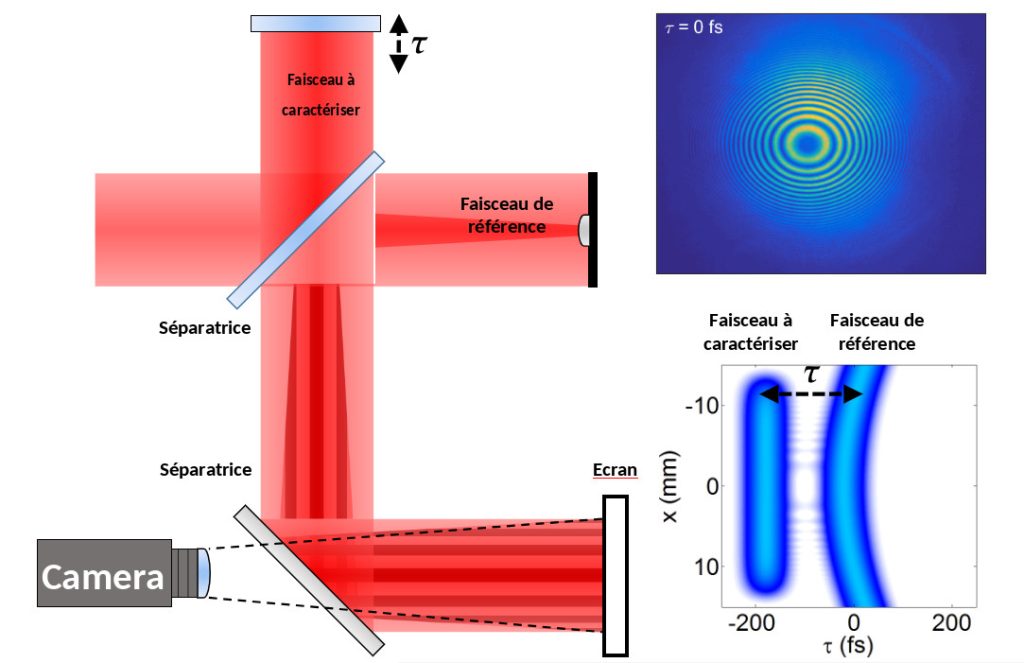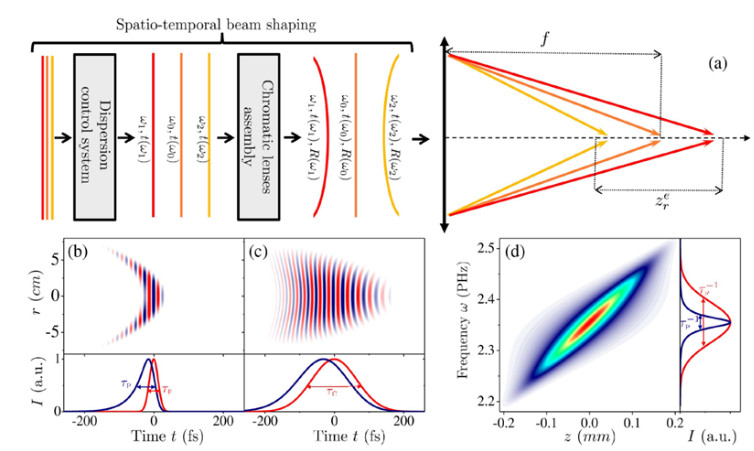Space-time measurement methods
Generating, shaping and using intense ultrashort laser pulses for HIFU experiments requires knowledge of the electric field E(x,y,z=z0,t) corresponding to the laser beam.
The impossibility of writing the field as the product of a function of space variables and a function of time leads to the presence of space-time couplings (STC).
These STCs do not allow the electric field to be determined sequentially from “classical” measurements in the time (or spectral) domain, followed by a measurement in the spatial domain.
Research into methods for measuring the complete electric field has been an area of intense activity over the last fifteen years, in which the laboratory has played a very active part, with the development of two measurement methods, TERMITES and INSIGHT.


TERMITES
The TERMITES method is based on the use of Fourier Transform Spectroscopy (FTS) combined with Point Diffraction Interferometry (PDI) and local field measurement in the time/spectral domain (SPIDER, SRSI, FROG).
INSIGHT
The INSIGHT method is based on the use of Fourier Transform Spectroscopy (FTS) combined with a method for determining the spatial phase from intensity measurements in 3 planes using an iterative Gerchberg-Saxton algorithm and local field measurements in the time/spectral domain (SPIDER, SRSI, FROG).

INSIGHT “Few Shots
INSIGHT requires a large number of pulses to complete a measurement. Reducing the number of shots required is an imperative for use on HIF laser chains with low repetition rates. The use of an interferometer based on a birefringent system instead of a Michelson has made it possible to improve measurement stability and accuracy, and to use signal processing methods (sub-sampling) to significantly reduce the number of shots required.

Pulse shaping
Studies of space-time couplings carried out in the laboratory have led us to propose and demonstrate a method, using the chromatism of a focusing system (generating pulse front curvature or PFC) and spectral dispersion (spectral chirp), which enables us to adjust the speed of the intensity maximum in the vicinity of the focus over an extended Rayleigh domain.
This type of spatio-temporal shaping is highly attractive for experiments in non-linear optics and laser-plasma interaction (particle acceleration, etc.), as has already been demonstrated.

Publications
- [Akturk 1] S.Akturk, XunGu, Pamela Bowlan and Rick Trebino “Spatio-temporal couplings in ultrashort laser pulses ” J. Opt. 12 (2010) 093001 (20pp)
- [Akturk 2] S. Akturk, X. Gu, P. Gabolde, and R. Trebino, “The general theory of first-order spatio-temporal distortions of Gaussian pulses and beams,” Opt. Express 13, 8642-8661 (2005)
- [Borot] A.Borot and F.Quéré, “Spatio-spectral metrology at focus of ultrashort lasers: a phase-retrieval approach,” Opt. Express 26, 26444-26461 (2018)
- [Dorrer] C.Dorrer “Spatiotemporal Metrology of Broadband Optical Pulses” IEEE Journal of Selected Topics in Quantum Electronics, vol. 25, no. 4, July/August 2019 3100216
- [Froula1] Froula, D.H., Turnbull, D., Davies, A.S. et al. Spatiotemporal control of laser intensity. Nature Photon 12, 262-265 (2018). https://doi.org/10.1038/s41566-018-0121-8
- [Froula2] D. H. Froula; J. P. Palastro; D. Turnbull; A. Davies; L. Nguyen; A. Howard; D. Ramsey;P. Franke; S.-W. Bahk; I. A. Begishev; R. Boni; J. Bromage; S. Bucht; R. K. Follett; D. Haberberger; G. W. Jenkins; J. Katz; T. J. Kessler; J. L. Shaw; J. Vieira “Flying focus: Spatial and temporal control of intensity for laser-based applications” Special Collection: Papers from the 60th Annual Meeting of the APS Division of Plasma Physics Phys. Plasmas 26, 032109 (2019)
- [Jeandet 1] A.Jeandet et al ” Spatio-temporal structure of a petawatt femtosecond laser beam” J. Phys. Photonics 1 035001 2019
- [Jeandet 2] A.Jeandet, S.Jolly, A.Borot,B.Bussiere, P.Dumont, J.Gautier, O.Gobert,J.P.Goddet, A.Gonsalves, A.Irman, W.Leemans, R.Lopez-Martens, G.Mennerat, K.Nakamura, M.Ouille, G.Pariente, M.Pittman, T.Puschel, F.Sanson, F.Sylla, C. Thaury, K. Zeil, and F.Quere “Survey of spatio-temporal couplings throughout high-power ultrashort lasers” Vol. 30, No. 3 / 31 Jan 2022 / Optics Express 3262
- [Jolly1] S.W. Jolly, O. Gobert and F.Quéré “Spatio-temporal characterization of ultrashort laser beams: a tutorial” J. Opt. 22 103501
- [Jolly 2] S.W.Jolly, O.Gobert, F.Quéré “Spatio-spectral characterization of ultrashort laser pulses with a birefringent delay line”, Vol. 4, No. 7 / 15 July 2021 /OSA Continuum 2044
- [Jolly 3] S.W. Jolly, Olivier Gobert, Antoine Jeandet, and Fabien Quéré, “Controlling the velocity of a femtosecond laser pulse using refractive lenses,” Opt. Express 28, 4888-4897 (2020)
- [Sainte-Marie] A. Sainte-Marie , O. Gobert, and F. Quéré, “Controlling the velocity of ultrashort light pulses in vacuum through spatio-temporal couplings,” Optica 4, 1298-1304 (2017)]

